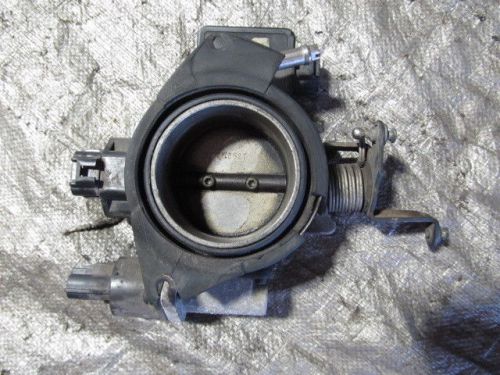2004 Jeep Grand Cherokee 4.0 Throttle Body

The 2004 Jeep Grand Cherokee WJ, particularly those equipped with the stalwart 4.0-liter inline-six engine, remains a popular choice for off-road enthusiasts and daily drivers alike. Central to this engine's operation is the throttle body, a component often overlooked yet crucial for delivering air to the combustion chamber. Understanding its function, common issues, and maintenance is vital for keeping your WJ running smoothly.
What Does the Throttle Body Do?
Simply put, the throttle body controls the amount of air entering the engine. It's located between the air intake and the intake manifold. Inside the throttle body is a throttle plate (or valve) that pivots open and closed. This plate is connected to the accelerator pedal via a cable (in the '04 WJ) or, in some modern vehicles, electronically via a throttle-by-wire system. When you press the gas pedal, the throttle plate opens, allowing more air to enter the engine. The engine control unit (ECU) then adjusts the fuel injection accordingly to maintain the correct air-fuel ratio for optimal combustion.
In the 4.0L Grand Cherokee, the throttle body is a relatively simple design, making it robust but not immune to wear and tear. Its size and design are specifically calibrated to provide the airflow needed for the engine's displacement and power output.
Common Problems with the 2004 Grand Cherokee 4.0L Throttle Body
Several issues can plague the 2004 Grand Cherokee's 4.0L throttle body:
- Carbon Buildup: This is the most common problem. Over time, deposits from oil vapor and crankcase ventilation accumulate on the throttle plate and throttle body walls. This buildup restricts airflow, leading to rough idling, poor acceleration, and even stalling. Symptoms often manifest as a fluctuating idle speed, especially when the engine is cold.
- Vacuum Leaks: Cracks or loose connections in the vacuum lines connected to the throttle body can create vacuum leaks. These leaks disrupt the air-fuel mixture, leading to similar symptoms as carbon buildup – rough idling, stalling, and poor fuel economy. A common culprit is the rubber hose connecting the throttle body to the idle air control (IAC) valve.
- Throttle Position Sensor (TPS) Failure: The TPS monitors the position of the throttle plate and sends this information to the ECU. A faulty TPS can provide inaccurate readings, causing erratic engine behavior, poor shifting (in automatic transmissions), and diagnostic trouble codes (DTCs).
- Idle Air Control (IAC) Valve Malfunction: The IAC valve regulates airflow when the throttle is closed, ensuring a smooth idle. A malfunctioning IAC valve can lead to stalling or a high idle speed. Cleaning the IAC valve is often a temporary fix, but replacement might be necessary.
Cleaning and Maintenance
Fortunately, cleaning the throttle body on a 2004 Grand Cherokee 4.0L is a relatively straightforward DIY task. You'll need throttle body cleaner (specifically designed for this purpose – carburetor cleaner is too harsh), a soft cloth or brush, and basic hand tools. Disconnecting the negative battery terminal is a must before starting any work.
The process typically involves removing the air intake duct, spraying the throttle body cleaner onto a clean cloth (never directly into the throttle body), and carefully wiping away the carbon deposits from the throttle plate and throttle body bore. Be sure to open the throttle plate manually to clean both sides. For heavier deposits, a soft brush can be used. Reassemble everything carefully, ensuring all connections are secure.
Regular cleaning (every 30,000-50,000 miles) can prevent many of the issues associated with carbon buildup. Inspecting vacuum lines for cracks and replacing them as needed is also good preventative maintenance. If problems persist after cleaning, consider replacing the TPS or IAC valve.
Troubleshooting and Diagnostics
If you're experiencing issues with your 2004 Grand Cherokee's 4.0L engine, a diagnostic scan tool can be invaluable. Common DTCs related to the throttle body include codes for the TPS, IAC valve, and vacuum leaks. However, remember that diagnostic codes are just clues; further investigation is often needed to pinpoint the root cause of the problem. A smoke test can be used to identify vacuum leaks, and a multimeter can be used to test the TPS for proper voltage output.
Compared to later model vehicles with more complex electronic throttle control systems, the 2004 Grand Cherokee's 4.0L throttle body is relatively simple to diagnose and repair. With basic maintenance and troubleshooting skills, you can keep your Jeep running reliably for years to come.
